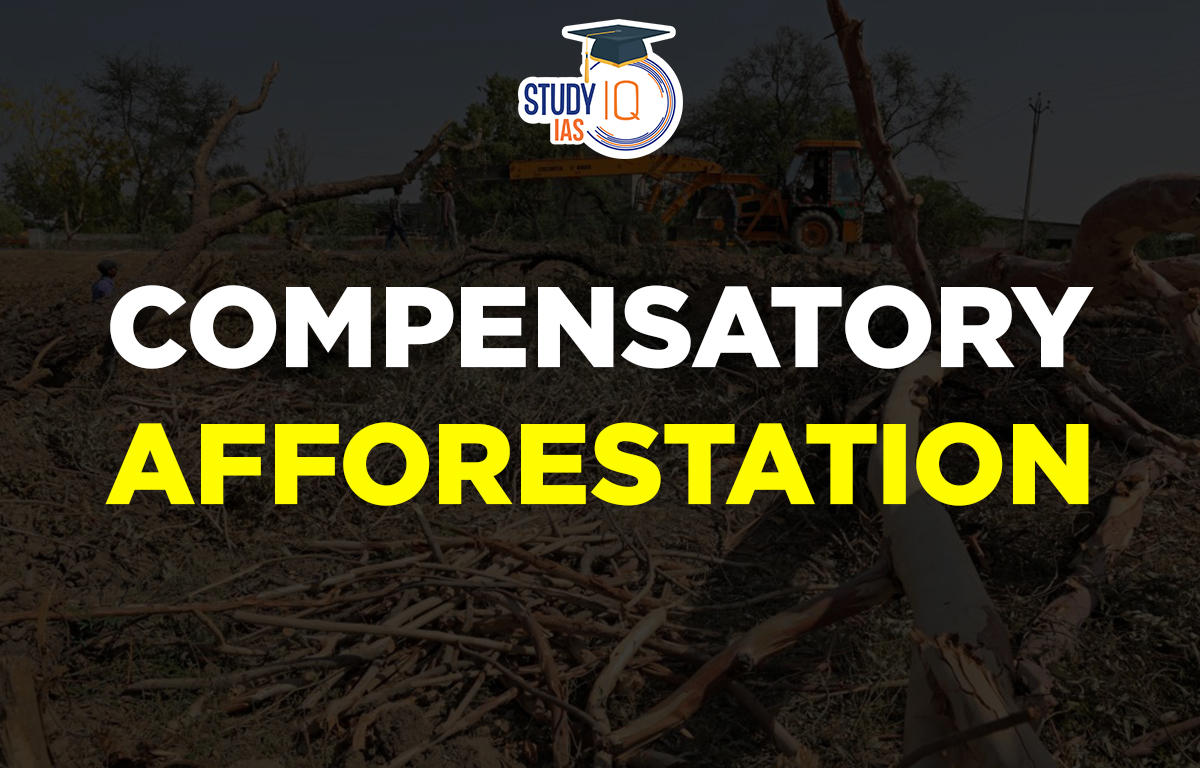Table of Contents
Context: India has promised to increase its forest and tree cover as part of its international climate change commitments.
What is Compensatory Afforestation?
- Compensatory afforestation means that every time forest land is diverted for non-forest purposes such as mining or industry, the user agency pays for planting forests over an equal area of non-forest land, or when such land is not available, twice the area of degraded forest land.

Compensatory Afforestation Fund (CAF) Act, 2016
- Aim: The Act seeks to mitigate the impact of diversion of forest land for non-forest purposes by making sure through a well-defined institutional mechanism, that the funds are released and utilized quickly, efficiently and transparently.
- The CAF Act was enacted to manage the funds collected for compensatory afforestation which till then was managed by ad hoc Compensatory Afforestation Fund Management and Planning Authority (CAMPA).
- Adhoc CAMPA was established following the Supreme Court’s Order (T.N. Godavarman Thirumulpad Vs Union of India case) in 2006 to manage the Compensatory Afforestation Fund (CAF).
- The CAF Act was enacted to manage the funds collected for compensatory afforestation which till then was managed by ad hoc Compensatory Afforestation Fund Management and Planning Authority (CAMPA).
- National and State Funds: The Act established a National Compensatory Afforestation Fund under the Public Account of India and State Compensatory Afforestation Fund under the Public Account of each state.
- The payments made for compensatory afforestation, net present value and others related to the project will be deposited in the fund.
- Net Present Value: The Act acknowledged the fact that newly afforested land cannot be expected to immediately start delivering the range of goods and services like timber, bamboo, fuelwood, carbon sequestration, soil conservation, water recharge, and seed dispersal that the diverted forests were providing.
- As a result, project developers are also asked to pay for the Net Present Value (NPV) of the forests being cleared based on a calculation decided by an expert committee.
- Distribution: The State Funds will receive 90% of the payments while National Fund will receive remaining 10%.
- Use of Funds: The funds can be used for the treatment of catchment areas, assisted natural generation, forest management, wildlife protection and management, relocation of villages from protected areas, managing human-wildlife conflicts, training and awareness generation, supply of wood saving devices, and allied activities.
Afforestation and Reforestation Programmes in India
- National Mission for a Green India: It is one of the eight Missions under the National Action Plan on Climate Change. It aims at protecting, restoring and enhancing India’s forest cover and responding to Climate Change.
- National Afforestation Programme (NAP) Scheme: The objective of this scheme is ecological restoration of degraded forests and to develop the forest resources with peoples’ participation, with focus on improvement in livelihoods of the forest-fringe communities, especially the poor.
- Namami Gange Programme: It is an Integrated Conservation Mission, approved as ‘Flagship Programme’ by the Union Government in June 2014 with budget outlay of Rs.20,000 Crore to accomplish the twin objectives of effective abatement of pollution, conservation and rejuvenation of National River Ganga.
- National Forest Policy (NFP), 1988: It encourages plantation of trees alongside roads, railway lines, rivers, streams, canals etc. under social forestry.
Problems with Compensatory Afforestation
- Greenwashing: According to some experts, compensatory afforestation has legitimised clearing of forests, and see it as an example of ‘greenwashing’.
- Greenwashing is when a company purports to be environmentally conscious for marketing purposes but isn’t making any notable sustainability efforts.
- The contrary view is that since the clearing of forests for one or the other purpose cannot be entirely eliminated, compensatory afforestation is a good mechanism for attempting to make up for these losses to some extent.
- Low Utilization of Funds: The money collected for compensatory afforestation before 2016 has remained largely unutilized. Serious work on compensatory afforestation has begun only after the 2016 Act.
- No Availability of Land: Lack of availability of suitable land remains the biggest problem for compensatory afforestation.
- The land that is made available for afforestation usually cannot be used for any other purpose and is often extremely unsuitable for growing plantations.
- Monoculture Plantations: Often the plantations are monocultures, meaning they contain only one species of plants. There is a lack of biodiversity. There is also biotic pressure, referring to the challenge the plantations face from nearby human habitations and cattle.
- Reductive View of Forests: According to some experts, the concept of compensatory afforestation works for the benefit of the biggest polluters of the planet.
- Projects that consume good forests can engage states or private entities to undertake paid plantations in distant regions despite no compatibility in terms of the qualities of what is lost and what is to be recreated.
- Parliamentary Standing Committee on Science and Technology, Environment and Forests (PSC) Report: According to the report, CAF Act 2016 has no time frame for creating compensatory forests, and is highly bureaucratic in operations.
























 WhatsApp
WhatsApp